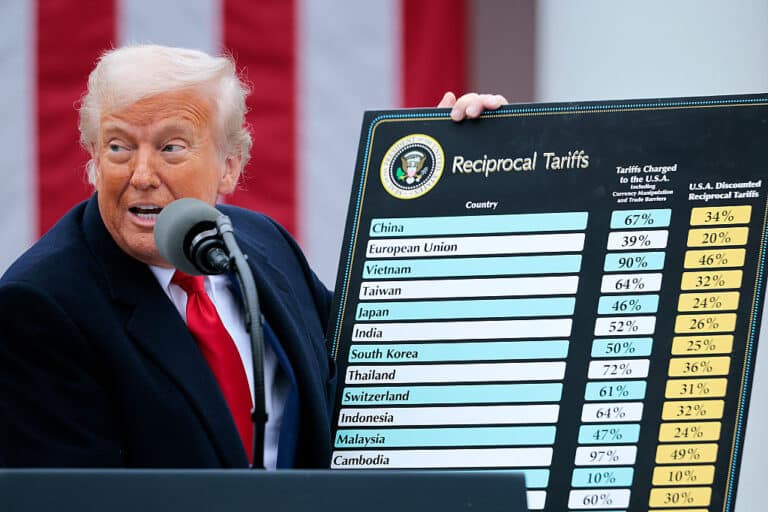Understanding Trump Tariffs: Impact on Global Trade, U.S. Economy, and Future Policy
Table of Contents

As Donald Trump ushered in a series of tariffs in his presidency, the world economy shook. Such Trump tariffs were not merely taxes on imports but a larger strategy to safeguard American businesses, counter China, and redefine global trade. So, what will be the impact on the US economy under Trump tariffs? What was the impact of Trump tariffs on global trade?
We are going to dissect it all in a simple conversational manner in this blog. Whether you are a student, business owner, or just need to know what all the commotion around the topic was to be about, with the help of this guide, you will be able to comprehend the actual outcomes of Trump’s import tax policy and where it might lead next. On we go!
What Are Trump Tariffs?

*The Kashmir Monitor
Before we discuss the Trump tariffs in particular, let’s define what tariffs are. Let us recapitulate briefly.
“A tariff is actually a tax that is imposed by the government on goods that are brought into the country via imported goods. In that way, when a foreign product has found its way in the U.S, the government can impose a slight penalty – this is the tariff.”
“Trump tariffs are the import taxes that were brought into effect under the presidency of Donald Trump. Trump’s import tax policy, and the majority of them were imposed in 2018-2020.” Such tariffs were components of a larger agenda, which involved shielding the American industries, cutting the trade deficit, and putting pressure on other countries involved in Trump’s trade war with China.
Why is Trump Using Tariff ?
You enter your favorite shop and you want to purchase a coffee maker. One of them is produced in the U.S. at 5,000 rupees. Another one is brought in by another country and sells for only 3500 rupees.
Which is taken by the majority of people?
Naturally, the less expensive one.
Suppose, therefore, that a tariff (import duty) of 2000 rupees is charged by the government on that foreign coffee maker. All of a sudden, it is no longer cheaper.
Result? Now you may choose the one that is made in the United States.
That is exactly the economic transition that former President Donald Trump’s import tax policy is working towards, but on a worldwide trade level.
So, how to explain why he uses tariffs, how it is supposed to work, and with examples that make the whole thing fall into place!
Why is Trump Using Tariffs?
- To Save American Jobs and Industries
Intent: The objective is to assist the American factories and employees by increasing the price of foreign goods.
Example:
Trump raised an import tariff on steel to 25 per cent. Why?
To shelter U.S. steelmakers against lower-priced steel imports from China as well as other nations.
This provided the local manufacturers with fair competitiveness.
- To Pressure Trade Partners (Such as China)
Agenda: Employ tariffs as a bargaining chip to compel the improvement of trade agreements.
Example:
Trump applied tariffs on over 360 billion dollars of Chinese products, accusing China of unjust trading arrangements and technology theft. This triggered Trump’s trade war with China, which resulted in strained negotiations, but later on a half-partial U.S.-China deal.
- To decrease the U.S. trade deficit
Objective: Purchase fewer foreign products, market more than Made in USA.
Example:
- America is purchasing more than it sells in countries such as Mexico and Germany.
- Car and electronic tariffs imposed by these nations would result in reducing imports in order to make Americans purchase locally.
- To Support Politically
Intent: Win the votes of blue-collar voters who feel that they were marginalized by the forces of globalization.
Example:
- In swing states that had a high number of factory workers, such as Michigan and Pennsylvania, Trump vowed to restart the manufacturing industry in the country by taxing imports and bringing manufacturing jobs back.
- It fitted into his America First policy.
- To Increment the Revenue (indirect)
Concern: To gather money in the form of tariffs, although it is not the primary objective.
Example:
During the Trump era, Tariffs brought more than 80 billion dollars to the government. But that burden usually would end up being transferred by way of higher prices to American businesses or consumers.
What Tariffs has Trump announced?
1. Steel and aluminium
On 12 March, a new tariff of the 25 percent tax on all steels and all metals (including aluminium) brought to the US was introduced, including all steel and metal products.
On 4 June, bringing it up to 50 percent. The US ranks second after the European Union as the leader in steel imports in the world and it imports most of the steel metal from Canada, Brazil, Mexico and South Korea.
2. European Union (EU)
In the initial stage, Trump proposed a 20 percent tariff on the majority of EU goods, and he reduced it to 10 percent up to 8 July to provide space to negotiate trade.
By the end of May, he was complaining about slow developments, and he issued a threat of a higher rate of 50% as of 1 June.
3. China
On 4 February, Trump announced a 10 percent tariff on Chinese imports that was increased to 20 percent a month later.
Beijing, in its turn, began to charge a 125 percent duty on certain US imports.
In May, following negotiations in Geneva, the US and China decided to cancel certain contracts completely and delay others for 90 days. The remaining 20 percent of the US strategies whose role is to pressurize Beijing to take further steps in limiting the illegal trade in fentanyl, a potent opioid medicine.
But both Washington and Beijing have since complained that the other party is flouting the agreed terms. And it began because of the trade war that Trump had with China
4. Canada and Mexico
There are also Trump tariffs that led him to launch his attacks on Canada and Mexico in February when he imposed a 25 percent tariff on the importation of goods to these two nations and a 10 percent tariff on Canadian energy. These tariffs have had several delays and exemptions.
Canada, thus, on 9 April, imposed a 25% tax on certain automobiles imported to the country, following the model of the US.
5. Cars
Since 2 April, an extra 25 percent levy has been imposed on the foreign cars. This was transferred to the imported engines and other car parts on 3 May. On 29 April, Trump toned down the regulations in order to avoid hurting the US automakers.
10 percent 7 baseline and increasing tariffs:
- Trump tariffs announced on 2 April that most countries, including the UK, would receive a 10 per cent baseline tariff on everything they deliver to the US.
- One week later, on 9 April, he announced a set of tariffs much more significant, on approximately 60 countries, labelled the worst offenders among America’s trading partners.
6. Smartphones and computers
On 12 April, an exemption for certain electronic equipment manufactured in China and other countries, such as smartphones and computers, was declared. Trump tariffs subsequently cautioned that this concession may not be long-lasting. On 23 May, the president threatened to levy a 25 percent import tax at least on Apple iPhones that are not produced in America.
7. Films
To support the U.S. film industry, Trump stated on May 4 that he would consider imposing a 100% tariff on foreign films.
What is the Impact of Trump Tariff on Global Trade?
The Trump tariffs hampered international trade because they made the goods between the U.S. and the countries with which it trades cost a lot of money. The nations that relied on commerce with the U.S. and China had to look elsewhere and rearrange the chains of supply. The tariffs caused a decline in the volume of international trade and uncertainty in the world economy. A lot of multinational corporations moved to evade tariffs. In general, it redefined trade patterns and trading routes around the world.
1. Impact on the US economy under Trump tariffs

*Harvard Buisness
Although the Trump tariffs were meant to promote American industries, the outcomes were not very encouraging. Some industries gained in the short run, such as the steel and aluminum industries, but others that depended on imports experienced increased prices. The counter-tariffs slapped by China hammered American farmers and brought in billions worth of government subsidies. It also reduced the speed of business investments because there was uncertainty in Trump’s trade war with China, and it had a slight effect of slowing the growth of the U.S. GDP.
2. Trump Tariffs' Effect on Consumers
The tax burden falls 100 percent on consumers
In the case of full burden being suffered by consumers, the consumption in 2030 declines by 3.5 percent and by over 3 percent in 2054. The decrease in imports means that foreigners buy less of the U.S. government debt; thus, the U.S. households must absorb an increased volume of the U.S. government debt and avoid investment in the productive capital of the private sector. With this rotation, in addition to less short-term investment because of greater economic uncertainty, the capital stock is reduced by 0.6 percent in 2030, and by almost 10 percent in 2054. Smaller capital means less productivity in the employees, and the wages are also lower, which means the households will also work a little less. Employment Unemployed: The wages earned will be 3.9 percent lower in 2054, whereas the hours worked will be 1.3 percent lower. The cut in the amount of private capital and a sense of fewer working hours result in output reduction of 5.1 percent by 2054. Nevertheless, increased taxation through tariffs allows lowering federal debt that, as of 2030, is more than 7.3 percent lower and, at 2054, 11.6 percent.
2030 | 2034 | 2039 | 2044 | 2049 | 2054 | |
Gross domestic product | -0.4 | -0.7 | -1.3 | -2.1 | -3.2 | -5.1 |
Capital stock | -0.6 | -1.3 | -2.5 | -4.0 | -6.1 | -9.6 |
Hours worked | -0.2 | -0.2 | -0.3 | -0.5 | -0.8 | -1.3 |
Average wage | -0.2 | -0.5 | -1.0 | -1.6 | -2.5 | -3.9 |
Consumption | -3.5 | -3.1 | -3.0 | -3.0 | -3.1 | -3.3 |
Debt held by the public | -7.3 | -9.9 | -11.3 | -12.0 | -12.1 | -11.6 |
The Trump's Import Tax Policy Good or Bad?
The idea of America First was reflected in the import tax policy of Trump tariffs, which was based on the high tariffs on foreign goods. The objective was to save American industries, lower trade deficits, and restore manufacturing jobs. To an extent, the policy worked- some of the U.S. industries, such as the steel industry, had suffered before but came back to life, and the U.S. also had more bargaining power during trade talks. Yet the downsides proved to be troublesome: the American firms were forced to pay more for the raw materials, the rural population was affected by retaliatory tariffs, and the citizens had to spend more on daily goods.
Economists are still in dispute. According to its proponents, this had been a daring move to solve decades of trade imbalances. Critics cite that it interfered with world trade, weakened international relations, and, in the end, held the economy back without long-term benefit.
Conclusion
The policy of the import tax by Trump was both advantageous and disadvantageous. Although it had a positive individual purpose to make American industries strong, the overall effect was both positive and negative in terms of its short- and long-term issues. It was good or bad from one view or the other, but without any doubt changed the U.S. trade policy and left an impression on the global economy.
Frequently Asked Questions
What are Trump's tariffs?
Trump tariffs refer to the import taxes imposed during Donald Trump’s presidency, mainly on goods from China and other countries. These tariffs aimed to protect U.S. industries and reduce trade deficits.
Why did Trump impose tariffs on China?
Trump believed China was engaging in unfair trade practices like intellectual property theft and government subsidies. Tariffs were used to pressure China to change these practices.
Which products were affected by Trump tariffs?
Thousands of products were impacted, including steel, aluminum, electronics, machinery, washing machines, and agricultural goods like soybeans.
Did Trump tariffs help the U.S. economy?
Some industries benefited, but others faced higher costs. The overall economic effect was mixed, with many experts saying the tariffs slowed economic growth.
How did Trump tariffs affect consumers?
Consumers often paid more for imported goods, as companies passed the added costs of tariffs to buyers. This led to higher prices on items like appliances and groceries.

















